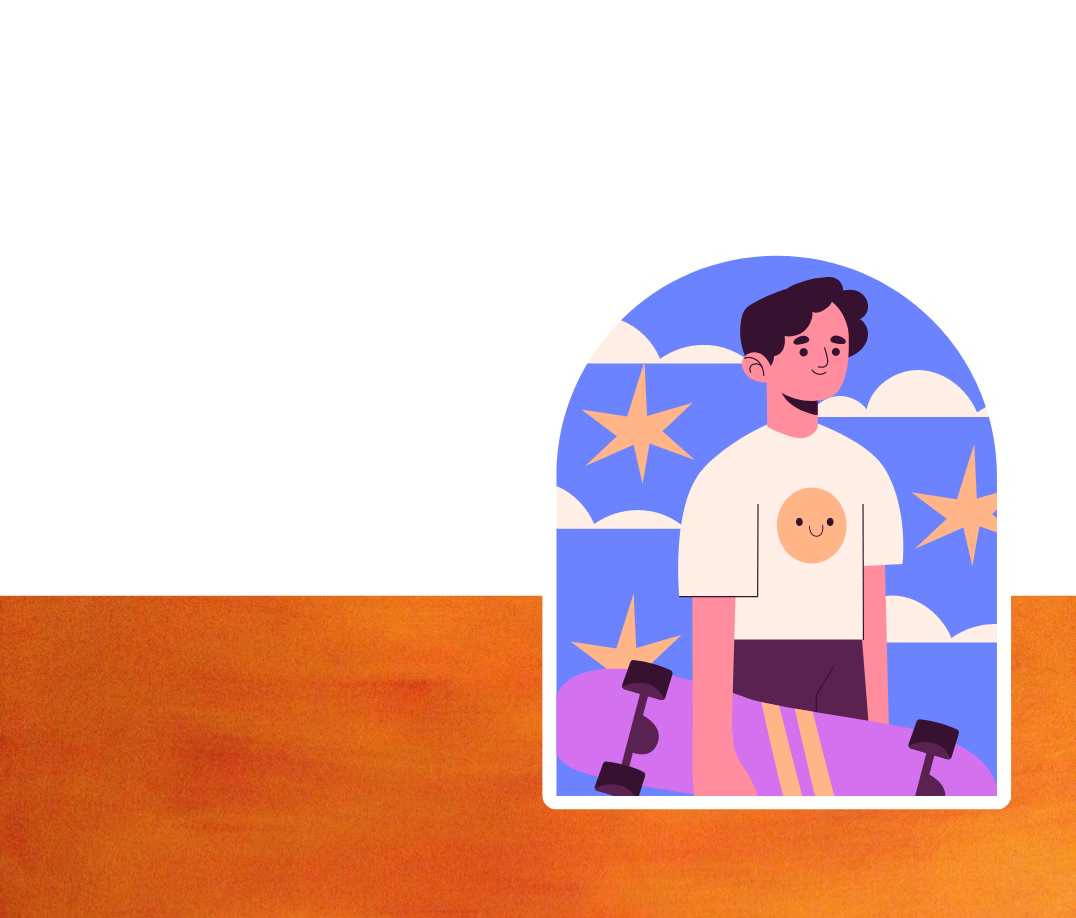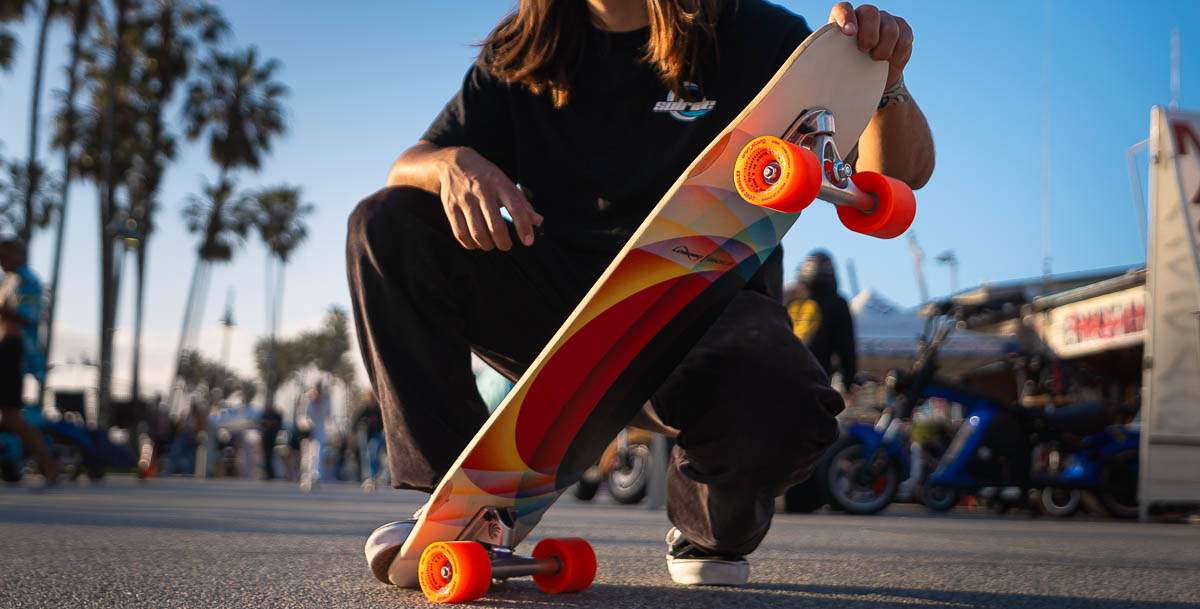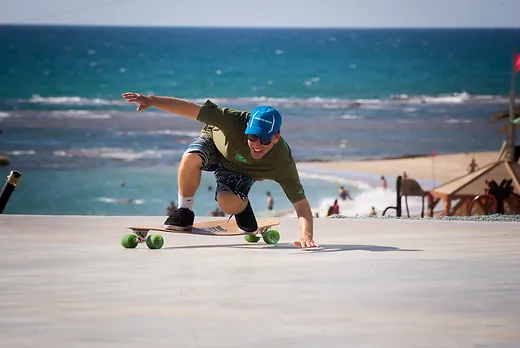16 min read • Mar 17, 2023
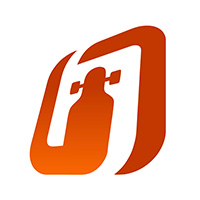
The Ultimate Guide to Longboard Skateboarding for Beginners
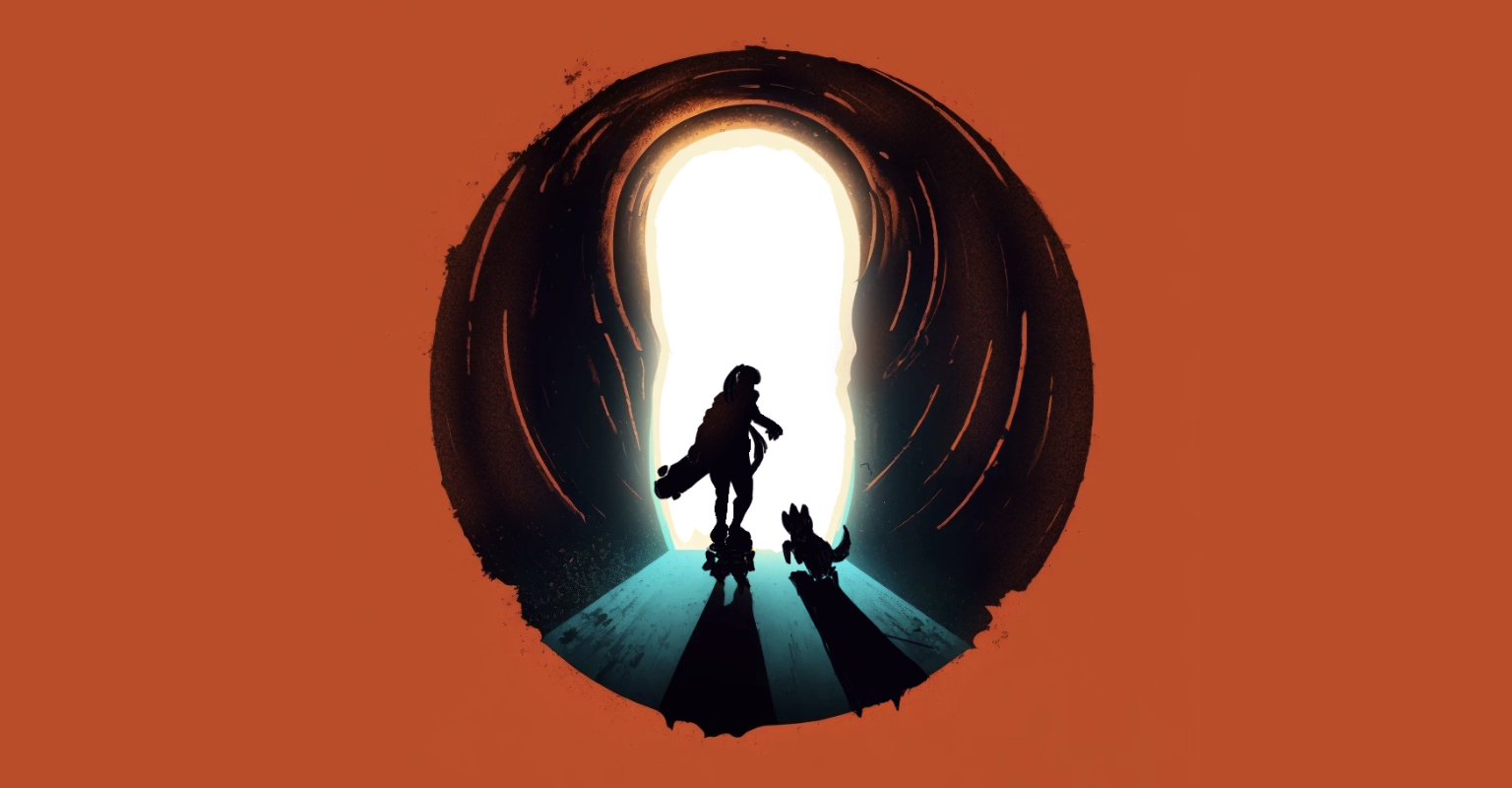
If you're interested in picking up a longboard and cruising around town, or if you're looking to dive into the worlds of longboard dancing or downhill racing, you've come to the right place. It’s not hard to learn to longboard. In this guide, we'll cover everything you need to know to get started, from the basics of longboarding to the different styles of riding to how to pick the best longboard for you.
Everything you need to know to about Longboarding and how to get started
What is longboarding?
Longboarding is a type of skateboarding that involves riding on a longboard, a skateboard with a longer deck and larger wheels. Longboards are generally more stable and easier to ride than traditional skateboards, making them popular for cruising and transportation. Though longboarding is a type of skateboarding (on a longer board), it’s definitely got its own vibe –generally more relaxed and laid-back vibe compared to the fast-paced style of skateboarding.
The point of longboarding, like any other activity or hobby, can have different meanings and purposes for different people. Some people enjoy longboarding as a form of transportation, using it as a way to get around town or commute to work or school. Others enjoy it as a form of exercise, using it as a way to get outdoors and stay active. Some longboarders enjoy the thrill and adrenaline rush of downhill riding, while others prefer the activity as a form of creative self-expression and creativity. Still others prefer cruising and exploring new places on their boards.
Longboarding can also be a social activity, with groups of friends getting together to ride and hang out. Finding community through a shared activity can be a really positive mental health tool!

The Houston Longboard Community posing after an event with Beyond the Board in 2022
Is longboarding the same as skateboarding?
Yes and no. A longboard is a type of skateboard. The main key difference between longboarding and skateboarding is (obviously) the size and shape of the board. Longboards have longer decks, often ranging from 32 inches to 60 inches, and are wider than traditional skateboards. This makes longboards more stable and easier to ride, especially at slower speeds. Longboards also have larger wheels, which provide a smoother ride and make it easier to roll over cracks and obstacles while riding around town.
Another difference between longboarding and skateboarding is the style of riding. Longboarding is often associated with a more relaxed and leisurely style of riding, with a focus on cruising and enjoying the ride. Skateboarding, on the other hand, often involves more fast-paced tricks and stunts. However, there is overlap between the two, and many longboarders enjoy incorporating tricks and slides into their riding style.
Longboarding compared to surfing and snowboarding
Do you already know how to surf or snowboard? Which sport is harder to learn differs per person. In our opinion, longboarding is easier than snowboarding and surfing. We find a feeling of safety in being able to bail on a board on land and more comfort in having full mobility of both feet. As soon as you stand on a longboard, you’re learning and improving. And there are so many accessible places to learn how to longboard – you don’t need an ocean or a mountain, all you need is your street, a deck, and four wheels!
The history of longboarding since the 1950s
The history of longboard skateboarding can be traced back to the 1950s, when surfers in California started riding skateboards as a way to practice their surfing moves on land when the waves were flat. As skateboarding gained popularity, the first longboards began to appear in the 1970s.
Early longboarders saw the sport as a form of self-expression, with a focus on cruising and enjoying the ride. This laid-back, relaxed culture was a departure from the fast-paced, trick-focused style of traditional skateboarding. Longboarding quickly gained popularity among surfers and skateboarders, and the sport began to evolve and develop its own unique culture.

This photo from Shred Shack shows how different boards from 1960s looked.
Over the years, longboarding has continued to grow and evolve, with different styles and techniques emerging. Today, longboarding is enjoyed by people all over the world, with a diverse community of riders and a rich culture that celebrates the freedom and creativity of the sport.
Who helped popularize modern longboard skateboarding?
There have been many individuals and groups who have contributed to the popularization of longboarding over the years. Some of the key figures in the history of longboard skateboarding include:
Adam and Adam
Adam Colton’s iconic tutorial videos on YouTube date back to 2006. Adam Stokowski has been pioneering freestyle on longboards since the late 2000s.
Brycin Stryker Lyons
Brycin is the founder of COASTLONGBOARDING, one of the first zines to be specifically tailored to longboarders (and downhill in particular). He’s also the organizer of the longest running downhill skate race—Attack of Danger Bay.
Loaded Boards
Loaded Boards is a longboard manufacturer that was founded in the 2000s. The company has played a key role in the popularization of longboarding. They're known for their high-quality boards and media that put a smile on the faces of riders all around the world.
Concrete Wave Magazine
Started in 2002 by Michael Brooke, was a unique contribution to the skate community early in the sport’s history. Brooke’s first magazine, International Longboarder, was the world's first longboard magazine, running from 1999–2002.
DockSession
The DockSession is a weekly longboard meetup that started in April 2014 in Paris, France by Lotfi Lamaali. DockSession has now expanded to over 20 countries around the world to become a worldwide longboard connection. The main intentions of the DockSessions are to help grow the longboard community and showcase skilled riders. Most importantly, it's there to create a link between all longboard communities around the world, help meet new people, have fun and spread the stoke!

Lotfi Lamaali at one of the original DockSession events in Paris 2014.
What are the different longboard riding styles?
There are different ways you can ride a longboard. The style you like may affect the board you pick or the places you go to ride.
Cruising
Cruising is an easy-going style of riding around and having fun. You don’t need to know any tricks to cruise—just how to push, ride, and stop.
You can add carves (or deep, connected turns) to your cruising style to help you slow down, turn, and maintain momentum.
Freestyle
Freestyle riders mix different styles together, including moves more common with skateboarding, like street skating. It can include longboard dance steps, tricks like kickflips, and slides.
Dancing
Longboard dancing has been steadily growing in popularity. This style is more accessible because it can be done on flat ground, and doesn’t involve high-risk flip tricks. Dancing on a longboard looks like fancy footwork and carving while maintaining balance.
Downhill
Downhill longboarding is the most dangerous of the styles because you’re going down hills that could have car traffic at speeds as high as 60 MPH. Downhill riders use slide gloves with plastic pucks on the palm to control slides around road bends. They often wear full-face helmets and full leather suits to avoid road rash.
Freeriding
Freeride longboarding is a style that’s in between downhill and freestyle. Freeriders make their way down a hill but can creatively incorporate slides and tricks. They still use slide gloves to help control movement.
Longboard anatomy
If you’re totally new to skateboarding and longboarding, here’s what you need to know when talking about boards:
All longboards have 3 basic components—the deck, the trucks, and the wheels.
- The deck is the platform you stand on. Some decks are directional, meaning they have a nose (front of the board) and tail (back of the board). Some decks are symmetrical, meaning the nose and the tail are shaped the same. Longer decks are more stable but slower to carve.
- The trucks are the axles attached to the deck that pivot and allow for turning. Wider trucks are more stable but slower to carve. If the board extends past the trucks, that’s known as a “kicktail.” Click to learn more about longboard trucks.
- The wheels attach to the trucks. Bigger wheels will roll faster but are heavier and take more effort to get to top speed.

Skateboard anatomy graphic from Sisteen Street
How to pick the best longboard for you
The best longboard for you depends on where and how you plan to ride. To get you started, think about these questions:
- What style of longboarding do you like?
- Where do you want to ride your longboard?
The best longboard for bombing a roughly-paved hill will be different from the longboard you use to just cruise on smooth pavement by the beach. Imagine it like this: you wouldn’t (or shouldn’t!) buy a sports car to go off-roading.
When you go into a skateshop or look online to buy a board, you can either buy just the deck, or you can buy the deck, trucks, and wheels all together and pre-assembled (called a “complete”). Buying a complete longboard as your first board makes total sense. But as you ride more and start to better understand the differences in longboard decks, trucks, and wheels, you’ll want to customize your board to be exactly what you’re looking for.
Regardless of what longboard you buy, it will be easier to ride a longboard than a skateboard or a Penny board. That’s because the longer deck and softer wheels will be more forgiving with balance, will make speed easier to maintain, and will give you a smoother ride.
What makes a good longboard?
A good longboard is one that you’ll have fun and be safe riding. How much you should spend on your first longboard could be anywhere from $10 (if you buy second-hand off someone) to $300 (for a performance-level complete setup). Like with guitars, it all depends how a board feels to you.
Different boards use different materials for the deck depending on the shape and flexibility. Maple is the most common material used, where you’ll see 6–9 ply (thin layers) glued together. Some boards might have bamboo, fiberglass, or even carbon fiber mixed in for added strength, durability, or feel.
Generally, we recommend just walking into your local skate shop to find a quality board. If you buy a cheap board online without knowing the brand, you could put yourself at risk if the board breaks on you (we’ve seen it happen!).
What kinds of longboard deck shapes are there?
The most noticeable difference between two boards will be the deck, so that’s what we’ll focus on when explaining the different types of boards.
Cruiser boards
Cruiser boards are typically cheaper and smaller (26–35”) than most other longboards—making them accessible and easy to bring with you. They’re made for riders that want something simple and affordable.
Best for:
- Cruising
- Carving
- Commuting
Pintail boards
Pintail boards are named for their distinct, surf-inspired shape of being wider at the nose and narrower at the tail. Pintail decks are generally flexier, which is good for cruising and carving, but bad for commuting. These boards are often a bit more affordable making them a great choice for beginner longboarders.
Best for:
- Cruising
- Carving
Dance and freestyle boards
Boards for longboard dancing and freestyle are big (up to 48”), stable, symmetrical, and typically have a bit of flex. This makes them both comfortable to ride and perfect for longboard tricks.
If you want something to vibe around on and learn some tricks, dance and freestyle boards are the way to go.
Best for:
- Dancing
- Freestyle
- Carving
Downhill and freeride boards
Downhill and freeride boards are generally similar in shape. These types of longboards are the most versatile of any category.
A board for racing is typically going to be smaller and minimalistic.
Freeride boards are often mid-sized with symmetrical decks. However, they can have directional decks with a flat nose and kicktail that make them look a bit like cruisers.
Best for:
- Freeriding
- Downhill
Drop through boards
Drop through boards have symmetrical, rigid decks without kicktails. The tail and nose have a hole cut out, and the trucks are mounted flush with the deck. This keeps the board lower to the ground, making it more stable at high speeds. But that also means they’re not as great at slower speeds, and tricks can be pretty limited.
Best for:
- Commuting
- Downhill
- Freeriding
Drop platform boards
Drop platform boards have symmetrical, rigid decks without kicktails. The trucks are still mounted under the deck, but the middle platform of the deck is lowered. These boards are more stable at high speeds, but aren’t as good at slower speeds, and tricks can be pretty limited.
Best for:
- Downhill
- Freeriding
- Freestyle
How do I start longboarding?
You can teach yourself to longboard! Grab your helmet, any other protective equipment you need, some skate shoes with flat, all-rubber soles, and your board. Find a quiet, flat spot with lots of space with no cars around.

Brooke Johnson teaching the basics of longboarding during a Beyond the Board event in Miami.
Goofy or regular stance?
The first thing you need to learn on a longboard is your stance. Try standing on the board with your left foot in front, then switch sides. One should be naturally more comfortable and easier to balance.
- If your left foot is in front, you’re regular.
- If your right foot is in front, you’re goofy.
Still struggling? Get a friend to push you from behind — whichever foot you stick out to catch yourself with should be your front foot.
Once you know your stance, it’s important to find your foot position on the board. Unlike a bicycle, longboards and skateboards don’t have specific places for your feet, hands, etc. This makes it difficult to know how to properly position yourself for maximum comfort and stability. Your basic riding position should be with your feet balanced right through the center of the board with your heels and toes touching each rail (long edge). In general, you should ride with your feet pointed forward slightly to make sure you’re steering from the front.
One common problem is that people ride with their back foot too far off the toe-side and their front foot too far off the heel-side edge. This creates a huge imbalance in weight distribution and will make it much more difficult to get comfortable with any speed or tricks.
But the biggest tip we can give you on your stance is this: bend your knees when longboarding! This will help you connect with your body to provide a better feeling of stability and balance.
Longboarding basics
Push
Foot position when pushing is a little different than when riding. When riding, your front foot will be at around 45º whereas it’ll be straight forward when pushing. This makes your stride more natural and ergonomic.
Stop
It’s important to never go faster than you can comfortably stop. In the beginning, jumping off your board definitely counts as a way to stop! You might feel fine riding at 30mph, but you never know when some car is going to pull out of a driveway or run through a stop sign. It happens more often than you think!
There are 3 main ways you can learn to slow down and stop on your longboard: foot braking, carving, and sliding.
Foot Brake
Carve
Turning on a longboard involves leaning your weight to one side or another. As you work up your balance, you can make slightly sharper turns, called carves. Because longboards are more flexible than skateboards, turning and carving will be easier and smoother.
Slide
Sliding is definitely the most advanced way to slow down, but it’s also the most useful when going at high speeds. If you don’t have gloves, get ‘em and use ‘em! Some people also call slides a "powerslide" or “check slide” because you’re checking your speed to slow down.
Fall
Yes, there is a right way to fall. And it’s important to know as soon as possible. Simply put, you want to transfer the momentum of your downward fall into sideways movement by rolling. This way, the fall gets distributed across your whole body, instead of having just one body part take the brunt of the fall.
Longboard dancing guru and DockSession founder, Lotfi Lamaali, even created a video on getting started with safety and learning how to fall on your longboard.
Now go out there and try it all yourself!
The first three tricks to learn on a longboard
We put together an article together about the first tricks to learn on a longboard and included instructional steps (with a video) that you can follow.
Conclusion
Longboarding is a fun and accessible activity that can be enjoyed by people of all ages and skill levels. Whether you're looking to cruise around town, explore new places, or even get into downhill racing, there's a style of longboarding that's right for you. By following the tips and advice outlined in this beginner's guide, you can get started on your longboarding journey with confidence and excitement. Remember to always prioritize safety and gradually build up your skills and techniques over time.
Happy riding 🤙

for skaters, with loads of love.© Circa 2021 - Amp Skate LLC
